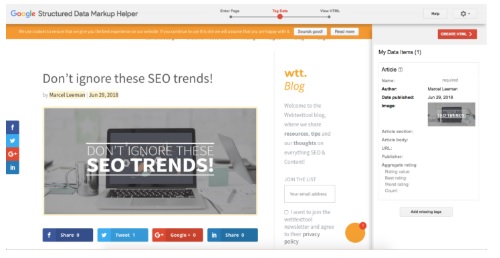Google has come a long way from being that boring list of blue links. Search any random topic, and you’ll get the information presented in a variety of ways: cards, statistics, lists, numbers. Many of those results are connected to structured data. In this article, you’ll read exactly what structured data is, how it’s connected to search engine optimization (SEO), and how you can apply it to achieve a higher search ranking in Google.
How structured data shows up in search results
Although the search giant’s algorithms become smarter every day, they still don’t quite understand exactly what the information on your website means. With structured data, you can lend Google a helping hand. It uses the data to present rich snippets and knowledge graphs. So, what does that look like?
Consider product information: what is the cost of an iPhone X?

Or the prep time for a recipe. Do I have enough time to make that quiche?
 What’s going on in Atlanta this week?
What’s going on in Atlanta this week?
What do consumers think of this vacuum cleaner?
How did the Yankees do today?
Who is the director of the MoMA?

A desktop search for the Los Angeles Zoo results in general information about the zoo, including ’notable animals’ like the gorillas Rapunzel and Jabari, orangutan Berani, and Alfred the seal.
Google gleans all this information from the structured data provided by websites. For general information, that info often comes from Wikipedia. For questions that are quick to answer (like sports scores), that can mean that people no longer need to click through to a website. This is also partially true for the featured snippet (or position zero) that we’ve written about before.
Check out: How to reach Google’s Position Zero [7-step plan]
Is structured data good for your SEO?
Generally, providing structured data can be a huge help in terms of search engine optimization:
- Google, Bing, and other search engines get a better understanding of what your site is all about and will rank it higher as a result.
- Visitors are more likely to click on rich snippets than on plain, dry text. That higher click-through ratio will also lead to a higher ranking.
Looks like it’s time to get started with structured data.
What is structured data exactly?
Maybe it’s a good idea to take a closer look at some structured data:
 Source: Google – Intro Structured Data
Source: Google – Intro Structured Data
This example is a piece of structured data from a recipe post on Grandma’s Apple Pie, which specifies the carbohydrate content and the preparation time. The kind of information that Google can easily include in its rich snippets.
Structured data is written in a number of different ‘languages’. For anyone who isn’t a tech nerd, it’s enough to know that the use of schema.org (the vocabulary list – for example: ‘ReviewCount’ stands for the number of reviews) with JSON-LD (the grammar rules that dictate how the vocabulary should be used) is currently the most popular combination.
How do I apply structured data to my website?
Do you need to become an expert in Schema.org and JSON-LD before you can add structured data to your online content?
No, thank goodness that’s not necessary.
For popular content management systems like WordPress or Joomla, there are a ton of plug-ins available to manage your structured data.
Even Google has created a Structured Data Markup Helper, which allows you to add data in different categories (articles, book reviews, datasets, events, movies, local businesses, products, restaurants, software applications, tv episodes, job postings).
Once you’ve tagged all the relevant data, simply click on ‘Create HTML’ to create the code that you can add to the head section of your page.
It can be quite interesting to poke around in this tool for ideas on which types of data to classify on your website pages.
Schema.org also has a handy overview of sector-specific lists with structured data tag suggestions.
This Google tool is designed to test whether you have correctly added structured data to your website.
When can I expect SEO results?
Please don’t expect an overnight change in your search results ranking after applying structured data.
It can often take multiple weeks before Google crawls your website again and registers any changes.
It’s also important to note that structured data won’t do you much good if you’re not paying attention to the basics of search engine optimization – a process that is easy to automate using Textmetrics!
But in the long run, systematically enriching your content with structured data will improve the chances of having your content appear as ‘rich snippets’ or ‘knowledge graphs’ in search results. That is great for your ranking as well as the number of visitors clicking through to your site.




